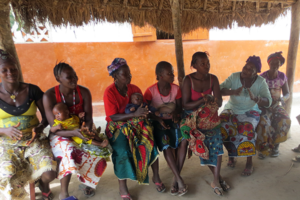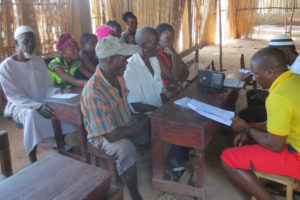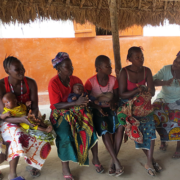Sierra Leone Radio Program Makes Connection between Peace of Mind and Taking Care of Health

For the past few months in Sierra Leone, this greeting has been broadcast across radios nationwide to introduce the “Get Kol Art” radio show, developed by the Health Communication Capacity Collaborative (HC3) and produced by Talking Drum Studios.
Everyone in Sierra Leone understands what it means to “get kol art” (which translates from Krio, the local language, to “have peace of mind”), but the connection between kol art and taking care of their health is not as clear to many. The radio show is the centerpiece of the larger “Get Kol Art, Pik Welbodi” national campaign, which urges Sierra Leoneans, particularly pregnant women and mothers with children, to go to health facilities for treatment of health issues and routine care. As the 20-episode series wraps up and the larger campaign continues, there are signs that people are starting to understand how taking care of their own health and the health of their family can help them have peace of mind.
Every week, in 93 communities across five districts, groups have gathered to listen to the radio program and discuss what they heard. Each radio listening group is led by a trained Community Champion, who guides the discussion and helps the group decide how they will take action on what they heard. These actions include talking to pregnant women and their husbands about danger signs in pregnancy, coming up with ideas for community bylaws, adding a new local food to their family’s diet and more. Participants from the listening groups have also taken it upon themselves to spread the word about what they learned.
 Pa Santigie Kargbo, an imam and leader of a listening group in Warima, described how his group shares what they learn from the program in their communities, bringing about shifts in the way people think and act.
Pa Santigie Kargbo, an imam and leader of a listening group in Warima, described how his group shares what they learn from the program in their communities, bringing about shifts in the way people think and act.
“The changes are many because when they come and listen, they go out and spread the message,” he said. “Now the women take their children to the hospital, as well as the pregnant women; there is a huge turnout of people to the clinic.”
Leaders of listening groups throughout the northern and western areas of the country shared similar observations about changes in their communities, with notable differences in the turnout of pregnant women and mothers with children at local health clinics.
Sierra Leone ranks near the bottom of global maternal and child health indicators, which is why these topics are the main focus of the Get Kol Art program. Before the program began, many Sierra Leoneans felt more comfortable going to a traditional healer or traditional birth attendant (TBA) when they needed to address a health issue.
“Before now, it was not easy to see somebody going to the hospital…,” said Andrew Thullah, a Community Champion in Makarie. “They had a strong belief in TBAs.”
This can be dangerous in a medical emergency since TBAs do not have the same level of medical knowledge, skills or tools as trained professionals. The result can be tragic, as was the case for several characters featured in the drama series on the Get Kol Art radio program.
The drama features relatable characters who face challenges, health issues and life events that are common in Sierra Leone. When asked to choose their favorite character, most people replied they liked Aminata best. Aminata is a character who learns a lot, mostly through difficult experiences and trial and error, about how to take care of herself, her pregnancy, her newborn baby and her family.
“The part I like is where Aminata learned [from her experience]…. Aminata had a miscarriage as a result of the treatment she was getting at home from Demoh [her mother-in-law and a TBA],” said Isha Sankoh, a nurse from Mamuntha. “So she learned her lesson and when she got her second pregnancy, she went to the hospital.”
Aminata’s husband also provided a good example of a man being involved in taking care of his family’s health. Alhaji Sankoh, notetaker for the listening group in Warima, shared that the program led him to start going to the clinic with his pregnant wife. Santigie Samuel Koroma, a Community Mobilizer in Mamuntha, also affirmed that the program: “taught us how to plan ahead when our wives are due.”
Another listener favorite is the discussion of family planning. Rachel Conteh, a mother from Makarie, noted: “The part I like most is the one encouraging us, wives and husbands, to plan our family together…. now that I have [listened to this program], I will come for family planning services so I will get welbodi and kol art.”
The Get Kol Art radio program is also generating an important shift in the way community-based health workers do their work. Abibatu Conteh, a nurse from Makarie, believes the character Demoh has given TBAs “the idea to come [to the clinic] with their people, because the people have strong belief in the TBAs. Now, the moment people go to them, they come with them to the clinic.”
Conteh said that when TBAs take patients to the clinic or community health workers make clinic referrals, it reduces the workload for nurses because they do not have to deal with as many emergencies.
There is no doubt the program has touched the lives of listeners, and its messages will continue to spread far and wide long after the last radio episode. Pa Santigie Kargbo articulated the lasting impact when he said: “whether the program ends or not, the message is in our hearts so wherever we go, we will continue and ensure the message is spread.”








Leave a Reply
Want to join the discussion?Feel free to contribute!